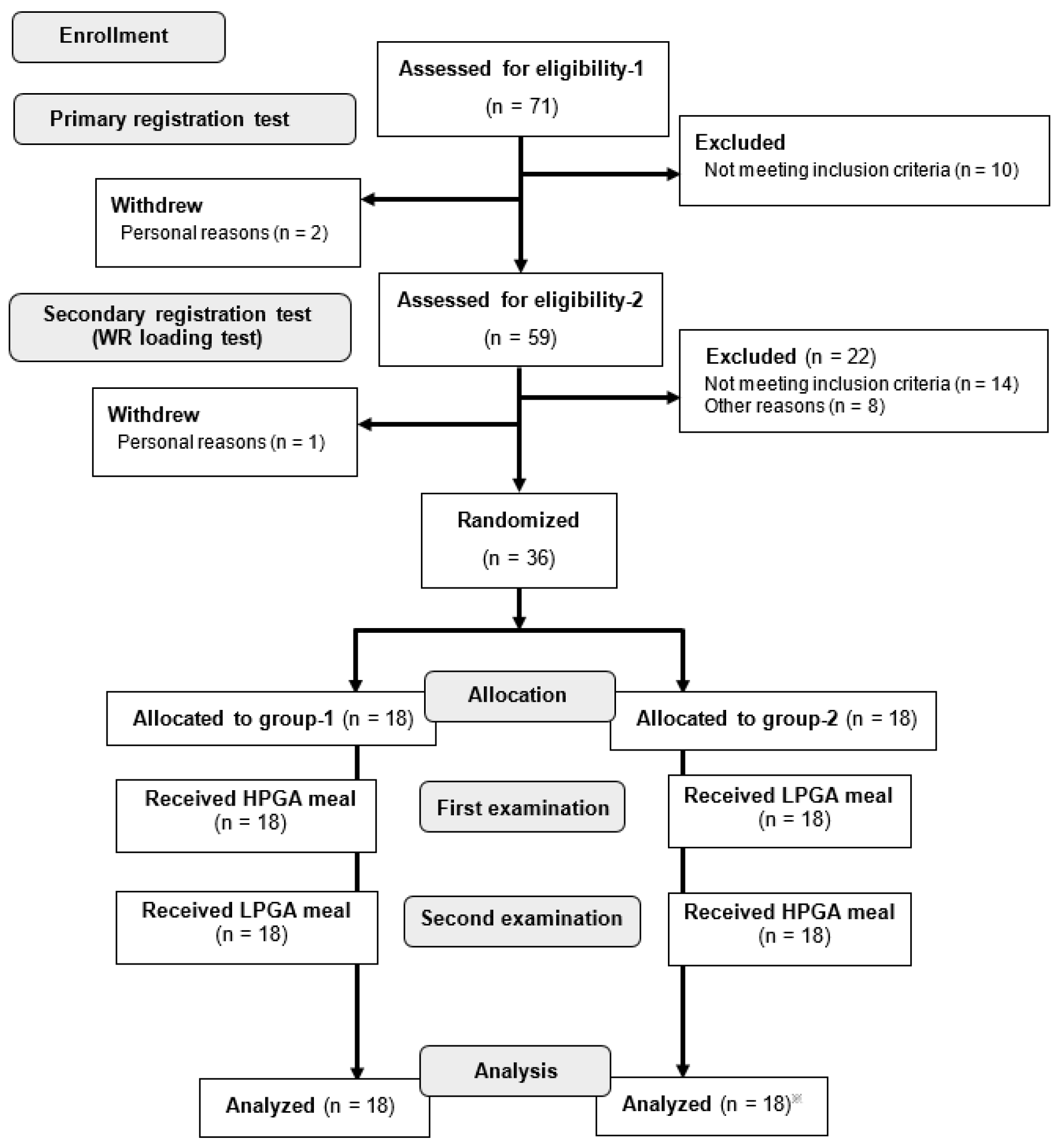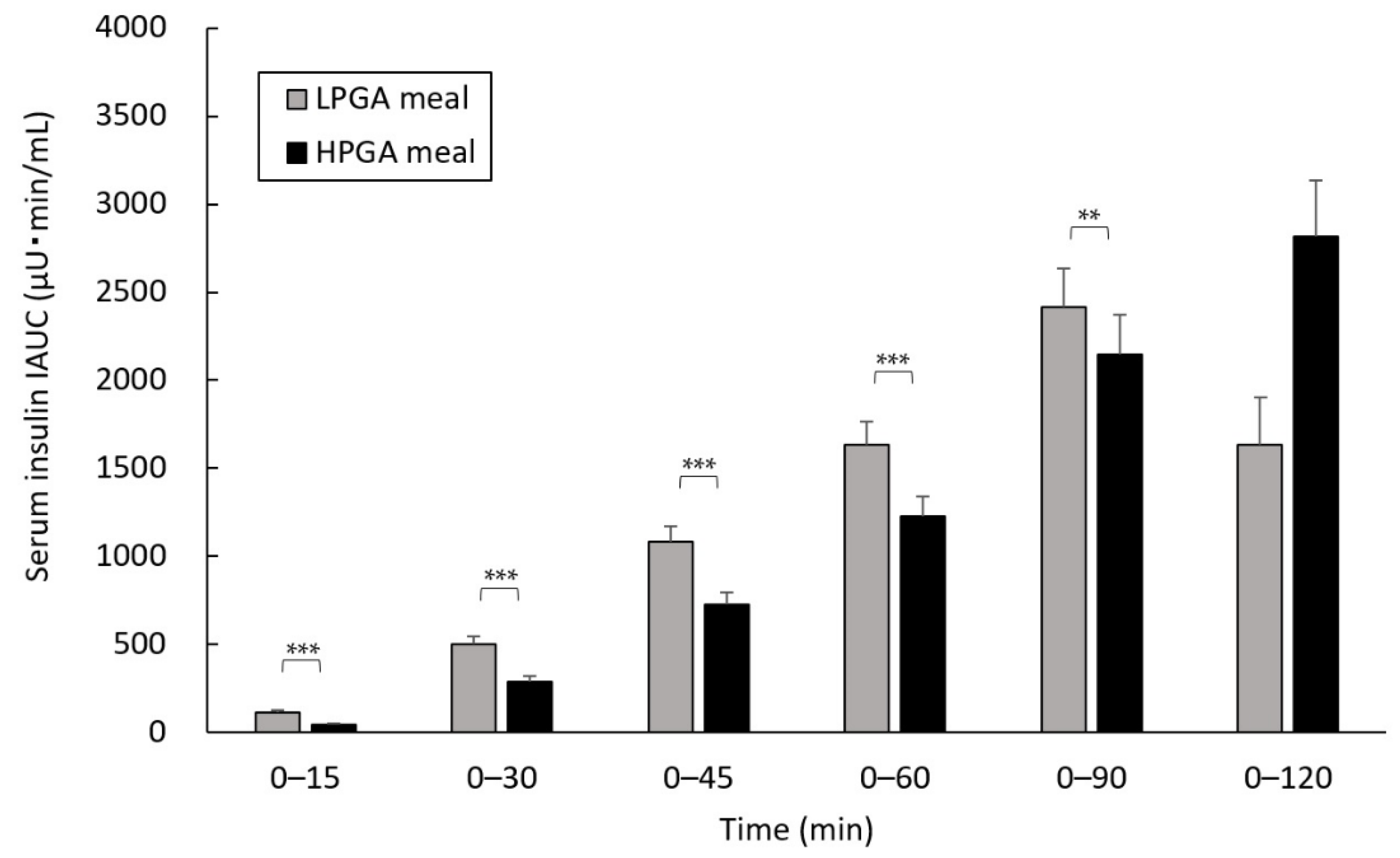Gamma-Polyglutamic Acid-Rich Natto Suppresses Postprandial Blood Glucose Response in the Early Phase after Meals: A Randomized Crossover Study
Abstract
1. Introduction
2. Materials and Methods
2.1. Participants
2.2. Study Protocol
2.3. Clinical Measurements
2.4. Blood Sample Analysis
2.5. Data Analysis
3. Results
3.1. Baseline Characteristics
3.2. Comparison of Blood Glucose IAUC between LPGA and HPGA Meals
3.3. Comparison of Blood Glucose IAUC Considering the Degree of Blood Glucose Increasing after WR Eating
3.4. Comparison of Serum Insulin IAUC between LPGA and HPGA Meals
4. Discussion
5. Conclusions
Author Contributions
Funding
Acknowledgments
Conflicts of Interest
References
- Maeda-Yamamoto, M.; Otani, T. Development of functional agricultural products utilizing the new health claim labeling system in Japan. Biosci. Biotechnol. Biochem. 2018, 82, 554–563. [Google Scholar] [CrossRef]
- Terada, A.; Yamamoto, M.; Yoshimura, E. Effect of the fermented soybean product “natto” on the composition and metabolic activity of the human fecal flora. Jpn. J. Food Microbiol. 1999, 16, 221–230. [Google Scholar] [CrossRef][Green Version]
- Jeon, Y.H.; Kwak, M.S.; Sung, M.H.; Kim, S.H.; Kim, M.H.; Chang, M.J. High-molecular-weight poly-gamma-glutamate protects against hypertriglyceridemic effects of a high-fructose diet in rat. J. Microbiol. Biotechnol. 2013, 23, 785–793. [Google Scholar] [CrossRef] [PubMed]
- Araki, R.; Fujie, K.; Yuine, N.; Watabe, Y.; Maruo, K.; Suzuki, H.; Hashimoto, K. The possibility of suppression of increased postprandial blood glucose levels by gamma-polyglutamic acid-rich natto in the early phase after eating: A randomized crossover pilot study. Nutrients 2020, 12, 915. [Google Scholar] [CrossRef]
- Rebello, C.J.; O’Neil, C.E.; Greenway, F.L. Dietary fiber and satiety: The effects of oats on satiety. Nutr. Rev. 2016, 74, 131–147. [Google Scholar] [CrossRef]
- Higa, M.; Fuse, Y.; Miyashita, N.; Fujitani, A.; Yamashita, K.; Ichijo, T.; Aoe, S.; Hirose, T. Effect of high β-glucan barley on postprandial blood glucose levels in subjects with normal glucose tolerance: Assessment by meal tolerance test and continuous glucose monitoring system. Clin. Nutr. Res. 2019, 8, 55–63. [Google Scholar] [CrossRef]
- Ames, N.; Blewett, H.; Storsley, J.; Thandapilly, S.J.; Zahradka, P.; Taylor, C. A double-blind randomized controlled trial testing the effect of a barley product containing varying amounts and types of fibre on the postprandial glucose response of healthy volunteers. Br. J. Nutr. 2015, 113, 1373–1383. [Google Scholar] [CrossRef]
- Tanemura, Y.; Yamanaka-Okumura, H.; Sakuma, M.; Nii, Y.; Taketani, Y.; Takeda, E. Effects of the intake of Undaria pinnatifida (Wakame) and its sporophylls (Mekabu) on postprandial glucose and insulin metabolism. J. Med. Investig. 2014, 61, 291–297. [Google Scholar] [CrossRef]
- Peddinti, G.; Bergman, M.; Tuomi, T.; Groop, L. 1-hour post-OGTT glucose improves the early prediction of type 2 diabetes by clinical and metabolic markers. J. Clin. Endocrinol. Metab. 2019, 104, 1131–1140. [Google Scholar] [CrossRef]
- Nonogaki, K. Dysglycemia and cardiovascular risk. J. Am. Coll. Cardiol. 2012, 60, 1121. [Google Scholar] [CrossRef] [PubMed][Green Version]
- Esposito, K.; Giugliano, D.; Nappo, F.; Marfella, R.; Campanian Postprandial Hyperglycemia Study Group. Regression of carotid atherosclerosis by control of postprandial hyperglycemia in type 2 diabetes mellitus. Circulation 2004, 110, 214–219. [Google Scholar] [CrossRef] [PubMed]
- Bennal, A.S.; Kerure, S.B. Glucose handling during menstrual cycle. Int. J. Reprod. Contracept. Obstet. Gynecol. 2013, 2, 284–287. [Google Scholar] [CrossRef]
- American Diabetes Association. Diagnosis and classification of diabetes mellitus. Diabetes Care 2014, 37 (Suppl. 1), S81–S90. [Google Scholar] [CrossRef] [PubMed]
- Taniguchi-Fukatsu, A.; Yamanaka-Okumura, H.; Naniwa-Kuroki, Y.; Nishida, Y.; Yamamoto, H.; Taketani, Y.; Takeda, E. Natto and viscous vegetables in a Japanese-style breakfast improved insulin sensitivity, lipid metabolism and oxidative stress in overweight subjects with impaired glucose tolerance. Br. J. Nutr. 2012, 107, 1184–1191. [Google Scholar] [CrossRef]
- Tai, M.M. A mathematical model for the determination of total area under glucose tolerance and other metabolic curves. Diabetes Care 1994, 17, 152–154. [Google Scholar] [CrossRef]
- Matthews, D.R.; Hosker, J.P.; Rudenski, A.S.; Naylor, B.A.; Treacher, D.F.; Turner, R.C. Homeostasis model assessment: Insulin resistance and beta-cell function from fasting plasma glucose and insulin concentrations in man. Diabetologia 1985, 28, 412–419. [Google Scholar] [CrossRef]
- Tamura, M.; Hori, S.; Inose, A.; Kobori, M. Effects of γ-polyglutamic acid on blood glucose and caecal short chain fatty acids in adult male mice. FNS Food Nutr. Sci. 2020, 11, 8–22. [Google Scholar]
- Würsch, P.; Pi-Sunyer, F.X. The role of viscous soluble fiber in the metabolic control of diabetes. A review with special emphasis on cereals rich in beta-glucan. Diabetes Care 1997, 20, 1774–1780. [Google Scholar] [CrossRef]
- Regand, A.; Chowdhury, Z.; Tosh, S.M.; Wolever, T.M.S.; Wood, P. The molecular weight, solubility and viscosity of oat beta-glucan affect human glycemic response by modifying starch digestibility. Food Chem. 2011, 129, 297–304. [Google Scholar] [CrossRef]
- He, K.; Shi, J.C.; Mao, X.M. Safety and efficacy of acarbose in the treatment of diabetes in Chinese patients. Ther. Clin. Risk Manag. 2014, 10, 505–511. [Google Scholar]
- Jenney, A.; Proietto, J.; O’Dea, K.; Nankervis, A.; Traianedes, K.; D’Embden, H. Low-dose acarbose improves glycemic control in NIDDM patients without changes in insulin sensitivity. Diabetes Care 1993, 16, 499–502. [Google Scholar] [CrossRef] [PubMed]
- Meneilly, G.S.; Ryan, E.A.; Radziuk, J.; Lau, D.C.; Yale, J.F.; Morais, J.; Chiasson, J.L.; Rabasa-Lhoret, R.; Maheux, P.; Tessier, D.; et al. Effect of acarbose on insulin sensitivity in elderly patients with diabetes. Diabetes Care 2000, 23, 1162–1167. [Google Scholar] [CrossRef] [PubMed]
- Delgado, H.; Lehmann, T.; Bobbioni-Harsch, E.; Ybarra, J.; Golay, A. Acarbose improves indirectly both insulin resistance and secretion in obese type 2 diabetic patients. Diabetes Metab. 2002, 28, 195–200. [Google Scholar] [PubMed]
- Moelands, S.V.; Lucassen, P.L.; Akkermans, R.P.; De Grauw, W.J.; Van de Laar, F.A. Alpha-glucosidase inhibitors for prevention or delay of type 2 diabetes mellitus and its associated complications in people at increased risk of developing type 2 diabetes mellitus. Cochrane Database Syst. Rev. 2018, 12, CD005061. [Google Scholar] [CrossRef] [PubMed]
- Ebrahimi, A.G.; Hollister-Lock, J.; Sullivan, B.A.; Tsuchida, R.; Bonner-Weir, S.; Weir, G.C. Beta cell identity changes with mild hyperglycemia: Implications for function, growth, and vulnerability. Mol. Metab. 2020, 35, 100959. [Google Scholar] [CrossRef] [PubMed]
- Node, K.; Inoue, T. Postprandial hyperglycemia as an etiological factor in vascular failure. Cardiovasc. Diabetol. 2009, 8, 23. [Google Scholar] [CrossRef]
- Jagannathan, R.; Sevick, M.A.; Flink, D.; Dankner, R.; Chetrit, A.; Roth, J.; Buysschaert, M.; Bergman, M. The 1-hour post-load glucose level is more effective than HbA1c for screening dysglycemia. Acta Diabetol. 2016, 53, 543–550. [Google Scholar] [CrossRef]
- Nakagomi, A.; Sunami, Y.; Okada, S.; Ohno, Y.; Shoji, T.; Fujisawa, T.; Kobayashi, Y. Association between 1-h post-load plasma glucose levels and arterial stiffness in normotensive subjects with normal glucose tolerance. Diabetes Vasc. Dis. Res. 2018, 15, 39–45. [Google Scholar] [CrossRef]
- Esposito, K.; Ciotola, M.; Carleo, D.; Schisano, B.; Sardelli, L.; Di Tommaso, D.; Misso, L.; Saccomanno, F.; Ceriello, A.; Giugliano, D. Post-meal glucose peaks at home associate with carotid intima-media thickness in type 2 diabetes. J. Clin. Endocrinol. Metab. 2008, 93, 1345–1350. [Google Scholar] [CrossRef]




| LPGA Natto | HPGA Natto | |
|---|---|---|
| Energy (kcal) | 76 | 77 |
| Protein (g) | 7.2 | 7.1 |
| Fat (g) | 3.6 | 3.9 |
| Carbohydrate (g) | 5.1 | 5.1 |
| Dietary fiber (g) | 3.3 | 2.5 |
| γ-PGA (mg) | 57.6 | 439.6 |
| Characteristic | Value |
|---|---|
| Number | 36 |
| Men/women (%) | 80.6/19.4 |
| Age (years) | 40.5 ± 16.4 |
| Body mass index (kg/m2) | 21.7 ± 1.7 |
| Fasting plasma glucose (mg/dL) | 89.6 ± 8.5 |
| Hemoglobin A1c (%) | 5.4 ± 0.2 |
| Insulin (µU/mL) | 5.2 ± 2.4 |
| Homeostasis model assessment of insulin resistance | 1.2 ± 0.6 |
© 2020 by the authors. Licensee MDPI, Basel, Switzerland. This article is an open access article distributed under the terms and conditions of the Creative Commons Attribution (CC BY) license (http://creativecommons.org/licenses/by/4.0/).
Share and Cite
Araki, R.; Yamada, T.; Maruo, K.; Araki, A.; Miyakawa, R.; Suzuki, H.; Hashimoto, K. Gamma-Polyglutamic Acid-Rich Natto Suppresses Postprandial Blood Glucose Response in the Early Phase after Meals: A Randomized Crossover Study. Nutrients 2020, 12, 2374. https://doi.org/10.3390/nu12082374
Araki R, Yamada T, Maruo K, Araki A, Miyakawa R, Suzuki H, Hashimoto K. Gamma-Polyglutamic Acid-Rich Natto Suppresses Postprandial Blood Glucose Response in the Early Phase after Meals: A Randomized Crossover Study. Nutrients. 2020; 12(8):2374. https://doi.org/10.3390/nu12082374
Chicago/Turabian StyleAraki, Risa, Takeshi Yamada, Kazushi Maruo, Akihiro Araki, Rena Miyakawa, Hiroaki Suzuki, and Koichi Hashimoto. 2020. "Gamma-Polyglutamic Acid-Rich Natto Suppresses Postprandial Blood Glucose Response in the Early Phase after Meals: A Randomized Crossover Study" Nutrients 12, no. 8: 2374. https://doi.org/10.3390/nu12082374
APA StyleAraki, R., Yamada, T., Maruo, K., Araki, A., Miyakawa, R., Suzuki, H., & Hashimoto, K. (2020). Gamma-Polyglutamic Acid-Rich Natto Suppresses Postprandial Blood Glucose Response in the Early Phase after Meals: A Randomized Crossover Study. Nutrients, 12(8), 2374. https://doi.org/10.3390/nu12082374





